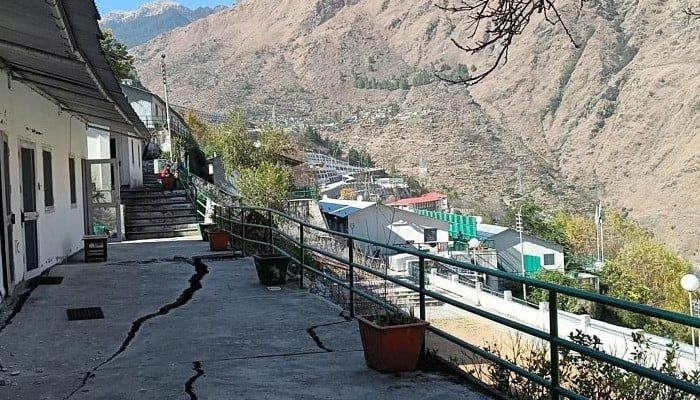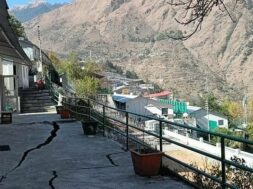
Manas Dasgupta
NEW DELHI, Jan 9: The Uttarakhand government has already evacuated some 4,000 people from about 600 “dangerous” houses in the “sinking” holy Himalayan town of Joshimath, official sources said. The evacuation was carried out after a survey via satellite and the evacuated people have been moved to safer places.
“As of now, we know that 600 houses have been evacuated and about 4,000 people have been shifted to safer areas,” the sources said. Some cracks were also noted in lower parts of Army and ITBP establishments but adequate safeguards are being adopted, the official said.
A high-level central team led by secretary, Border Management, Dr Dharmendra Singh Gangwar reached Dehradun and met Chief Minister Pushkar Singh Dhami. “Surveys are being conducted by NDRF and local administration to get to exact numbers,” a senior Home Ministry official explained.
It seems 30 per cent of Joshimath is affected, he said, adding. “A report is being compiled by an expert committee and it would be submitted to the Prime Minister’s Office.” The district administration had earlier put red cross marks on more than 200 houses in the sinking town that are unsafe for living. It asked their occupants to either shift to the temporary relief centres or rented accommodations for which each family would get assistance of ₹ 4,000 per month for the next six months from the state government.
Personnel of the National Disaster Response Force and State Disaster Response Force have been deployed for the relief and rescue efforts in the town. More than 600 structures in Joshimath – gateway to Badrinath and Hemkunt Sahib, major pilgrimage centres of Hindus and Sikhs respectively, have either developed cracks or been partially destroyed. The holy town has been divided into three zones – ‘Danger’, ‘Buffer’, and ‘Completely safe’ – based on the magnitude of possible danger.
Experts have blamed unplanned infrastructure development, including hydropower projects, for the alarming situation. Many have pointed to the hydroelectricity project of National Thermal Power Corporation (NTPC) in this connection. The NTPC has denied these charges. In an official statement, it has said the NTPC tunnel doesn’t go under the town and no blasting work is being carried out at the site at this point.
Joshimath, however, is not the first case of land subsidence in Uttarakhand. Over the last couple of years, numerous villages in districts across the state have been awaiting relocation due to the vulnerability of the habitat due to the impact of extreme weather events.
In June-July 2021, cracks in houses similar to those in Joshimath were found in the Raini village located on the river banks at the confluence of the Rishi Ganga and Dhauli Ganga about 22 km from Joshimath. It is on the Joshimath-Malari Road in the Chamoli district at the north-western edge of Nanda Devi National Park.
The Uttarakhand government appointed a team of geologists to survey the village, which was found unfit for habitation subsequently. Recommending the evacuation of the Raini village, the survey and report found that the village was vulnerable and required “slope stabilisation” to keep it from subsiding further. “Presently, the Raini village is facing serious slope stability problems where the whole habituated area is affected by the active subsidence whereas the downslope is affected by the toe erosion. During the investigation, wide cracks were observed in the walls and floors of many houses indicating active slope movement in the area. It is therefore advisable to rehabilitate the Raini village to an alternate safe location,” said the survey report.
On February 7, 2021, Raini was severely struck by a flash flood caused by a portion of the Nanda Devi glacier being torn away and causing a glacial lake outburst flood and ran downstream of the Rishi Ganga River and the Dhauli Ganga River and in turn the Alaknanda, the major headstream of the Ganga. Before hitting the village and destroying, the flood had destroyed the Rishi Ganga Dam and power plant.
The flood severely damaged the foothills of the Raini village, leading to wide cracks of between 5 cm to 10 cm on the service road as well as structures in the village, found geologists of the Uttarakhand Disaster Recovery Initiative.
Chamoli and Bageshwar districts in Uttarakhand also experienced torrential rain in June of 2021, with Bageshwar recording excess rain to the tune of 175 per cent with a total of 901.3 mm of rain from June 1-July 27 against the normal of 327.9 mm. Similarly, Chamoli witnessed a surplus of rain by 423 per cent between June 9-15, and an excess of 863 per cent of rain between June 23-30.
The flood comprises colluvium with high flow intensity also caused to disturb in the slope face area and slope forming strata got disturbed. Some noticeable damages to the residential structures on top of the slope and also some slip zones were identified where tensional cracks and erosion took place,” the state government report said.
“During the field visit, it was observed that the slope-forming material is highly saturated due to incessant rainfall. The soil/debris material loses its strength when the slope-forming material gets saturated. As a result, there are many slips area observed in the village from toe to uphill of the slope. In addition to this, soil erosion is also observed along the localised water channels,” it said.
The survey found, that like in the case of Joshimath, Raini village was located on old landslide debris material. The report also warned against hill-slope cutting for road construction which posed a threat of “slope failure” and recommended properly implemented “drainage provisions’’ to divert surface run-off during the monsoons.
“Mountains of Uttarakhand are ecologically very fragile. On top of that, deforestation, rapid urbanisation and ever-increasing construction work have made the situation even worse. The state is already vulnerable to natural disasters and the slightest impact of climate change or global warming can result in mass destruction,” said G P Sharma, President, Meteorology and Climate Change, Skymet Weather.
“We have already started witnessing impacts of climate change in terms of extreme weather events like cloudbursts, flash floods, landslides, or glacial outbursts. If the rise in global temperatures remains unchecked, we would see an increase in monsoon rainfall. To be more precise, we would see a rise in extreme weather events, which can be very dangerous for the hilly states,” added Sharma.














